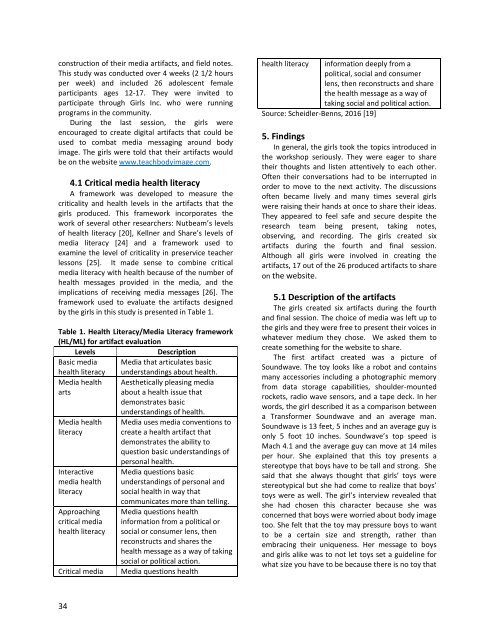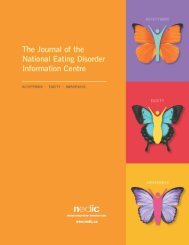NEDIC Conference Journal 2018
You also want an ePaper? Increase the reach of your titles
YUMPU automatically turns print PDFs into web optimized ePapers that Google loves.
construction of their media artifacts, and field notes.<br />
This study was conducted over 4 weeks (2 1/2 hours<br />
per week) and included 26 adolescent female<br />
participants ages 12-17. They were invited to<br />
participate through Girls Inc. who were running<br />
programs in the community.<br />
During the last session, the girls were<br />
encouraged to create digital artifacts that could be<br />
used to combat media messaging around body<br />
image. The girls were told that their artifacts would<br />
be on the website www.teachbodyimage.com.<br />
4.1 Critical media health literacy<br />
A framework was developed to measure the<br />
criticality and health levels in the artifacts that the<br />
girls produced. This framework incorporates the<br />
work of several other researchers: Nutbeam’s levels<br />
of health literacy [20], Kellner and Share’s levels of<br />
media literacy [24] and a framework used to<br />
examine the level of criticality in preservice teacher<br />
lessons [25]. It made sense to combine critical<br />
media literacy with health because of the number of<br />
health messages provided in the media, and the<br />
implications of receiving media messages [26]. The<br />
framework used to evaluate the artifacts designed<br />
by the girls in this study is presented in Table 1.<br />
Table 1. Health Literacy/Media Literacy framework<br />
(HL/ML) for artifact evaluation<br />
Levels<br />
Description<br />
Basic media Media that articulates basic<br />
health literacy understandings about health.<br />
Media health Aesthetically pleasing media<br />
arts<br />
about a health issue that<br />
demonstrates basic<br />
understandings of health.<br />
Media health<br />
literacy<br />
Interactive<br />
media health<br />
literacy<br />
Approaching<br />
critical media<br />
health literacy<br />
Critical media<br />
Media uses media conventions to<br />
create a health artifact that<br />
demonstrates the ability to<br />
question basic understandings of<br />
personal health.<br />
Media questions basic<br />
understandings of personal and<br />
social health in way that<br />
communicates more than telling.<br />
Media questions health<br />
information from a political or<br />
social or consumer lens, then<br />
reconstructs and shares the<br />
health message as a way of taking<br />
social or political action.<br />
Media questions health<br />
health literacy information deeply from a<br />
political, social and consumer<br />
lens, then reconstructs and share<br />
the health message as a way of<br />
taking social and political action.<br />
Source: Scheidler-Benns, 2016 [19]<br />
5. Findings<br />
In general, the girls took the topics introduced in<br />
the workshop seriously. They were eager to share<br />
their thoughts and listen attentively to each other.<br />
Often their conversations had to be interrupted in<br />
order to move to the next activity. The discussions<br />
often became lively and many times several girls<br />
were raising their hands at once to share their ideas.<br />
They appeared to feel safe and secure despite the<br />
research team being present, taking notes,<br />
observing, and recording. The girls created six<br />
artifacts during the fourth and final session.<br />
Although all girls were involved in creating the<br />
artifacts, 17 out of the 26 produced artifacts to share<br />
on the website.<br />
5.1 Description of the artifacts<br />
The girls created six artifacts during the fourth<br />
and final session. The choice of media was left up to<br />
the girls and they were free to present their voices in<br />
whatever medium they chose. We asked them to<br />
create something for the website to share.<br />
The first artifact created was a picture of<br />
Soundwave. The toy looks like a robot and contains<br />
many accessories including a photographic memory<br />
from data storage capabilities, shoulder-mounted<br />
rockets, radio wave sensors, and a tape deck. In her<br />
words, the girl described it as a comparison between<br />
a Transformer Soundwave and an average man.<br />
Soundwave is 13 feet, 5 inches and an average guy is<br />
only 5 foot 10 inches. Soundwave’s top speed is<br />
Mach 4.1 and the average guy can move at 14 miles<br />
per hour. She explained that this toy presents a<br />
stereotype that boys have to be tall and strong. She<br />
said that she always thought that girls’ toys were<br />
stereotypical but she had come to realize that boys’<br />
toys were as well. The girl’s interview revealed that<br />
she had chosen this character because she was<br />
concerned that boys were worried about body image<br />
too. She felt that the toy may pressure boys to want<br />
to be a certain size and strength, rather than<br />
embracing their uniqueness. Her message to boys<br />
and girls alike was to not let toys set a guideline for<br />
what size you have to be because there is no toy that<br />
34




